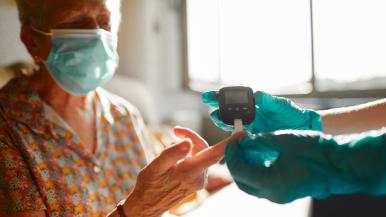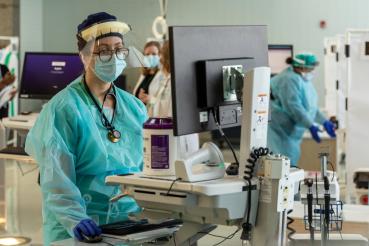Amid the many problems posed by the pandemic, one positive outcome is that COVID-19 is providing valuable insights that could help researchers unlock the secrets of another intractable disease: diabetes.
At RUSH, researchers are using data gathered during the pandemic to understand the connection between the two diseases and why COVID-19 affects people with diabetes differently.
People with diabetes face higher COVID-19 risks
Over the past two years, data has shown that people with type 2 diabetes are more likely to develop severe COVID-19 that leads to hospitalization and sometimes death — and the reason is likely inflammation, says Rasa Kazlauskaite, MD, MS, director of the Diabetes Technology Program at Rush University Medical Center and a RUSH endocrinologist.
“People with type 2 diabetes typically have chronic, low-level inflammation that is difficult to detect in clinical practice,” she says. “When they become infected with SARS-CoV-2, the virus that causes COVID-19, this low-level inflammation can become hyperinflammation that affects their lungs, heart and other parts of the body.” This hyperinflammation is what likely leads to more severe complications from COVID-19, she says.
Having diabetes may also put people at risk for “long COVID,” or what doctors call post-acute sequelae of SARS CoV-2 infection, or PASC, says Alan Landay, PhD, vice chair of research and division chief of translational and precision medicine in the Department of Internal Medicine at RUSH.
“In patients with diabetes, there’s a disordered metabolic environment that actually enhances the replication of the virus,” Landay says. “That may create a higher susceptibility to the virus, and it may also affect the clinical outcomes in those patients. But it’s not one-size-fits-all.”
To find out why only some people with diabetes develop COVID-19 complications, scientists at RUSH and the nonprofit research institute RTI International have been monitoring COVID-19 in patients with diabetes in Chicago as well as in Malaysia for comparison. So far, scientists have tracked differences in outcomes by age, sex, race/ethnicity, body mass index and other factors in 5,712 patients, with results to be published later this year.
Insights into different ways that diabetes develops
Beyond trying to understand why some people with diabetes have worse outcomes from COVID-19 than others, researchers also hope to gain more insights into how diabetes develops. Scientists already know that for some people, it’s not just a faulty immune system that triggers type 1 diabetes or insulin resistance that leads to type 2 diabetes. The National Institute of Diabetes, Digestive and Kidney Diseases recognizes more than 50 different ways that a person can develop diabetes, from defects in a single gene to other health issues like liver disease.
“Ideally, we would like to investigate each and every one of those 50 causes,” Kazlauskaite says. “And we are finding that some people have several diabetes causes at the same time. In other words, a patient may not just have the purely insulin-resistant type of diabetes, what’s typically defined as type 2, but they might also be affected by steroids or autoimmune diabetes at the same time.” Doctors may call this “hybrid diabetes,” suggesting that the etiology, or cause, of diabetes may be much more complex than originally believed.
Could COVID-19 be a new cause of diabetes?
It’s possible, Kazlauskaite says. A study recently published in the medical journal Lancet found that people who survived COVID have a 40% higher risk for developing diabetes. She believes many of the new cases of type 2 diabetes are occurring in people with pre-diabetes who don’t know it.
“People might have pre-diabetes with chronic, subclinical inflammation before they get COVID-19. So, when they do get infected with the virus, they could develop hyperinflammation that causes metabolic stress and more insulin resistance. As a result, they manifest overt diabetes,” she says.
Another theory is that COVID-19 disrupts the immune system. “We know hyperinflammation can cause autoimmune disease. When this happens, the immune system gets ‘confused’ and starts attacking its own tissues, including insulin-producing cells in the pancreas,” she says. This is the process that causes type 1 diabetes, which primarily develops in childhood but may also affect adults.
A third theory is that steroids given during COVID-19 treatment could cause diabetes because they often raise blood glucose, Kazlauskaite says. For some patients, glucose levels return to normal after the steroids have been discontinued, but for others, the effects are lasting.
A fourth reported hypothesis is that COVID-19 can cause severe inflammation of the pancreas (known as pancreatitis), where the body’s insulin-producing cells reside. This can trigger diabetes, although it is relatively rare, Kazlauskaite says.
Testing better ways to treat diabetes
Beyond trying to understand the link between COVID-19 and diabetes, doctors at RUSH strive to improve care for patients with both conditions. Like other types of infections, COVID-19 can make existing diabetes worse. That is why controlling glucose in hospitalized patients with both conditions is so critical, Kazlauskaite says.
To help nurses monitor blood sugar levels in these patients at RUSH, Kazlauskaite and her team have been testing continuous glucose monitoring technology that allows nurses to keep an eye on patients’ glucose from the nurses’ station.
Called inpatient glucose telemetry, the technology alerts nurses before a patient’s blood sugar gets into the danger zone. The telemetry project at RUSH was made possible through a generous donation from Thomas and Aferdita Merkel (Aferdita received her bachelor’s and master’s degrees in nursing from the Rush University College of Nursing). So far, data suggests that patients with COVID-19 and diabetes fare better when their glucose is well controlled.
“It’s not only a good thing for patient safety, but it’s also good from the nurses’ perspective,” Kazlauskaite says.
Learn more about the RUSH approach to diabetes care.




